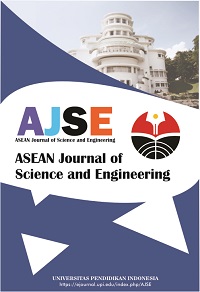Eco-Friendly Concrete Innovation in Civil Engineering
Abstract
Keywords
Full Text:
PDFReferences
Ahmad, I. A., Taufieq, N. A. S., and Aras, A. H. (2009). Analisis pengaruh temperatur terhadap kuat tekan beton. Jurnal Teknik Sipil ITB, 16(2), 63-70.
Amelia, R., Suhendra, S., and Amalia, K. R. (2021). Hubungan Faktor-Faktor yang Mempengaruhi Kuat Tekan Beton. Jurnal Talenta Sipil, 4(2), 225-235.
Bhanja, S., and Sengupta, B. (2005). Influence of silica fume on the tensile strength of concrete. Cement and Concrete Research, 35(4), 743-747.
Ciocan, V., Burlacu, A., Bărbuță, M., Verdeș, M., Șerbănoiu, A. A., and Ștefan, I. (2018). Eco-friendly concrete from wastes. Environmental Engineering & Management Journal (EEMJ), 16(12), 2969-2976.
Jangin, A. I., Samsurizal, E., and Supriyadi, A. (2016). Studi eksperimental beton ramah lingkungan menggunakan kulit kemiri sebagai agregat kasar. Jurnal Mahasiswa Teknik Sipil Universitas Tanjungpura, 2(2), 1-12.
Kandi, Y. S., Ramang, R., and Cornelis, R. (2012). Substitusi Agregat Halus Beton Menggunakan Kapur Alam dan Menggunakan Pasir Laut pada Campuran Beton. Jurnal Teknik Sipil, 1(4), 74-86.
Raval, A. D., Patel, D. I. N., and Pitroda, P. J. (2013). Ceramic waste: Effective replacement of cement for establishing sustainable concrete. International Journal of Engineering Trends and Technology (IJETT), 4(6), 2324-2329.
Reddy, M. V. S., Ashalatha, K., and Surendra, K. (2006). Studies on eco-friendly concrete by partial replacement of cement with Alccofine and fine Fly Ash. micron, 10, d90.
Suhendro, B. (2014). Toward green concrete for better sustainable environment. Procedia Engineering, 95, 305-320.
Susilorini, R. M. R., Hardjasaputra, H., Tudjono, S., Hapsari, G., Wahyu, S. R., Hadikusumo, G., and Sucipto, J. (2014). The advantage of natural polymer modified mortar with seaweed: green construction material innovation for sustainable concrete. Procedia Engineering, 95, 419-425.
Tangadagi, R. B., Manjunatha, M., Bharath, A., and Preethi, S. (2020). Utilization of steel slag as an eco-friendly material in concrete for construction. Journal of Green Engineering, 10(5), 2408-2419.
Widyawati, R. (2011). Studi Kuat Tekan Beton Beragregat Ramah Lingkungan. Jurnal Rekayasa Teknik Sipil Universitas Lampung, 15(3), 140975.
Yu, J., Mishra, D. K., Wu, C., and Leung, C. K. (2018). Very high-volume fly ash green concrete for applications in India. Waste Management & Research, 36(6), 520-526.
DOI: https://doi.org/10.17509/ajse.v1i3.39475
Refbacks
- There are currently no refbacks.
Copyright (c) 1970 Universitas Pendidikan Indonesia

This work is licensed under a Creative Commons Attribution-ShareAlike 4.0 International License.












